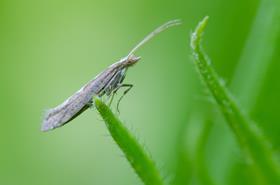
A new grower-led initiative has been launched by AHDB to promote better regional monitoring of ‘super pest’ diamondback moth.
Part of the organisation’s Pest Bulletin, which is set to return for the 2018 season, the new scheme puts growers at the heart of monitoring the problem insect.
Brassica growers in some parts of the UK have struggled to control the pest, which is resistant to most pesticides, since a diamondback moth infestationin 2016. This has caused significant damage to cabbage, cauliflower and other brassica crops.
Brassica growers are currently monitoring diamondback moth populations across Cornwall, Devon, Warwickshire, Lincolnshire, Yorkshire, Lancashire and Fife, with the first sighting report coming in from West Sussex.
Dr Rosemary Collier, director of Warwick Crop Centre at the University of Warwick, said: “This year there will be even more detailed information on pest moths, particularly diamondback moth, as a result of the new crop monitoring initiative led by UK brassica growers.
“The mass invasion of migrant diamondback moths in 2016 showed how important it is to keep up to date with what is happening nationally and internationally with such a potentially devastating pest and we now have good evidence that it can survive our winter weather – in south-west England at least.”
Hosted by Syngenta, the AHDB Pest Bulletin provides growers with essential pest forecasts and up-to-date reports on most of the key field crop pests, indicating periods when infestations are likely to occur, to help growers make informed pest control decisions.
Data is collected from various locations around the UK, giving regional information, as well as historical data to provide year-on-year comparisons of pest numbers.
“The last few weeks have been relatively cold, delaying the development of certain pests,” Collier said. “In 2016 and 2017 we caught the first carrot flies at Wellesbourne on 1 and 7 March respectively, while we're still waiting to catch the first fly of 2018.
“Similarly we had caught quite a few cabbage root flies in our yellow water traps by this time last year, but have only captured one fly this year so far.However, a few pests such as pollen beetles, bean seed flies and cabbage stem weevils have been on the wing for a couple of weeks at least and have been reported in the AHDB Pest Blog.”
The results of the grower-led diamondback moth monitoring will be published each week as part of the Pest Bulletin and growers are invited to share their findings on the pest.
If you would like to receive weekly pest updates, you can sign uphere.



